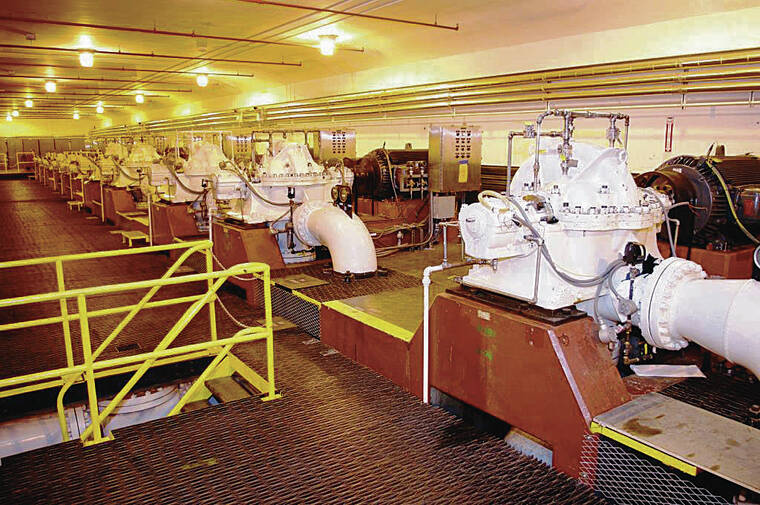The smell of fuel around the neighborhoods of Foster Village and Aliamanu on Saturday night, near the site of a fuel spill from the Navy’s Red Hill fuel facility, was strong enough that several residents called 911 and multiple units from
the Honolulu Fire Department and Federal Fire Department responded.
At the time, the Honolulu Fire Department believed that the smell was due to the refueling of storage tanks in the vicinity, and the department closed out the incident at
8:23 p.m. Saturday, according to Louise Kim McCoy, a spokeswoman for HFD.
But on Monday the Navy told the Honolulu Star-Advertiser that the odor was likely the result of the leak from a fire suppression drain line that was detected Saturday evening and not contained until Monday at 2 a.m. The Navy said approximately 14,000 gallons of fuel and water was released and that all of the mixture was contained and placed in an above-ground storage tank as of midday Monday.
“While there were other fuel operations going on that day, they are in no way connected to this incident,” said Lydia Robertson, a spokeswoman for Navy Region
Hawaii, by email. “All fuel operations were stopped when this incident occurred.”
The Navy says it is still investigating the cause of this weekend’s fuel release. It’s not clear why there was fuel and water in the fire suppression drain line, or what caused it to spill.
Robertson said that when the fire suppression system is activated, “any fire fighting material that is released gets funneled to a (large hole in the tunnel that is lined).” From there, pumps push the liquid into the drain line.
However, Robertson said that the water is not “necessarily an indicator that the fire suppression system was activated.”
The state Department of Health, which has regulatory authority over the Red Hill Underground Fuel Facility, said that it’s investigating the leak and that “information is pending.”
This latest leak at the Navy’s aging Red Hill facility has elicited a new round of criticism against the Navy and its management of the fuel facility, which contains 20 massive underground tanks that provide fuel to military operations in the Indo-Asia-Pacific region. The Navy says Red Hill is part of the nation’s critical infrastructure and can also provide a vital source of fuel for Hawaii during disasters and emergencies.
But the Honolulu Board of Water Supply, Hawaii Sierra Club and numerous local lawmakers have been concerned for years that the facility poses a grave risk to Oahu’s drinking water supply. The tanks sit just 100 feet above a critical groundwater aquifer.
Rep. Aaron Johanson
(D, Aiea-Moanalua-Foster Village-Fort Shafter), who represents the area around Red Hill, said the latest leak was particularly disconcerting because of the proximity to residential neighborhoods.
“Whether it is with respect to water quality, or the land and the soil, or even the potential for a fire hazard, what is so alarming is that all this infrastructure is embedded, or in and around, our communities,” said Johanson. “So these issues aren’t occurring in an unpopulated area in the middle of nowhere. There’s suburbia in and all around it.”
The Navy has also been under fire from Hawaii’s congressional delegation, which earlier this month requested the U.S. Department of Defense’s Inspector General to launch an independent investigation into whether the Navy “covered up evidence or intentionally delayed”
notifying state regulators about a separate leak of fuel into Pearl Harbor.
U.S. Sen. Mazie Hirono told the Star-Advertiser in a statement Monday that she was “concerned and angry to learn of yet another incident at Red Hill.”
“We need a thorough investigation to get to the bottom of what is happening with both the operations and infrastructure at the facility,” said Hirono.
The Hawaii Sierra Club, which is engaged in a contentious contested case hearing with the Navy over its pending request for a state permit to continue operating the facility, also expressed alarm. The environmental group has increasingly pressed the Navy to relocate its tanks, an undertaking that the Navy says could cost upward of $10 billion and take years to complete.
“The fact that the Navy simply cannot guarantee our safety is growing ever more undeniable,” said Wayne Tanaka, director of the Hawaii Sierra Club, by email. “Beyond the fact that we now appear to have an undetected, unknown release of fuel at the facility, is the additional concern that
the facility’s fire suppression system may now be compromised.
“If there’s anything that you need to have working at all times in a fuel storage facility, it is the system that will supposedly help keep it from turning it into a
150 million gallon fuel bomb.”
Tanaka said it was troubling that the Navy has provided so little information about the latest incident. It “indicates that either they still have no idea what might have happened, or they do have more information and are choosing, again, to hide information from the public,” said Tanaka. “Either scenario is also terrifying, and
unacceptable.”

